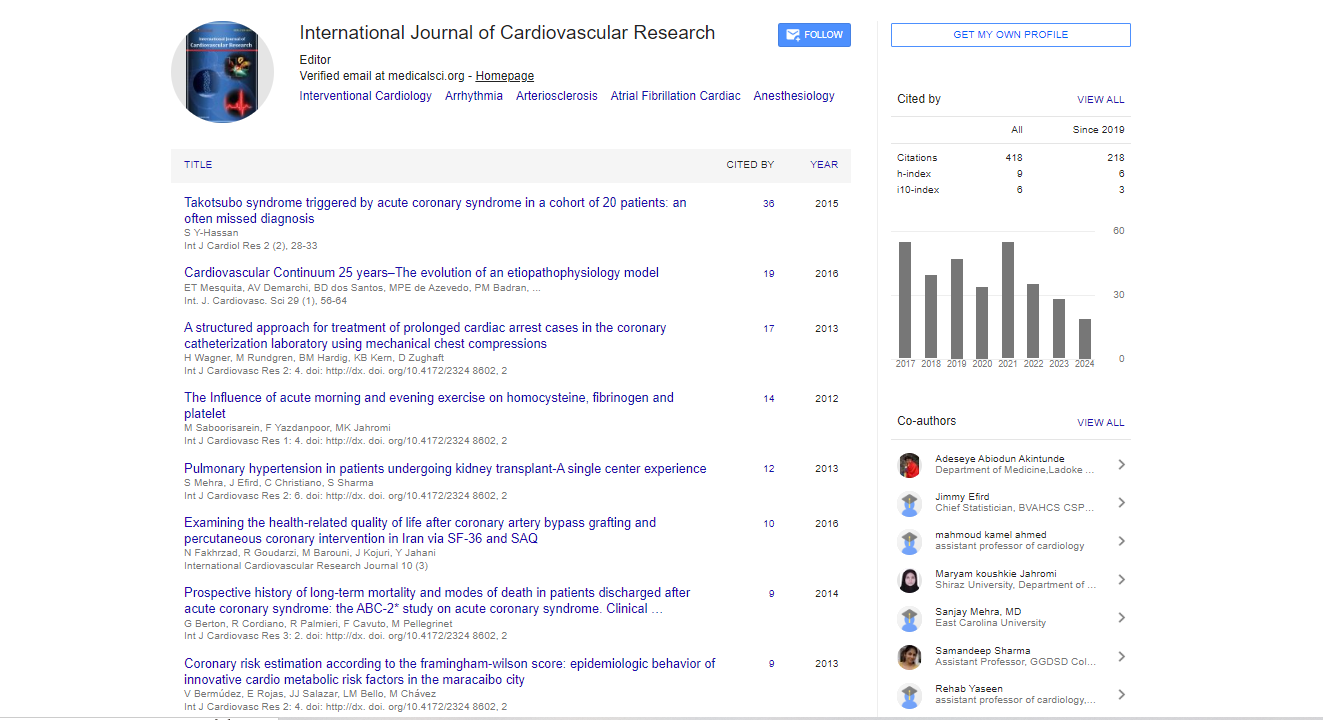Short Communication, Int J Cardiovasc Res Vol: 9 Issue: 5
A Short Note on Arrhythmia
Ashwini Mattapalli*
Department of Pharmacy, Sri Indu Institute of Pharmacy, Hyderabad, India
*Corresponding Author: Dr. Ashwini mattapalli
Doctor of Pharmacy, Department of Pharmacy, Sri Indu Institute of Pharmacy, Hyderabad, India
E-mail: Mamatharockzz94@gmail.com
Received: August 10, 2020 Accepted: August 24, 2020 Published: August 31, 2020
Citation: Mattapalli A (2020) A Short Note on Arrhythmia. Int J Cardiovasc Res 9:5. doi: 10.37532/icrj.2020.9(5).413
Abstract
The heart is the central organ of the body. The heart supplies blood to every part of the body as result carrying the oxygen and exchanging it with the co2 and helping the respiratory system. The heart never stops its beat if it happens then the condition leads to death. The healthy heart beat every second the doctor identifies the heart beat by counting the number of times the heart beats every minute when the person in in the resting phase. It usually varies from every single individual. The healthy heart beat is usually between 60 and 100 beats for minute. Heart rate can also be measured through their pulse at different locations like wrist, insides of the elbows, side of the neck and top of the foot.
Keywords: Heart diseases; Tachycardia; Bradycardia; Atrial fibrillation.
Introduction
Arrhythmia is a condition with irregular heartbeat. During the arrhythmias the heart may beat too fast or sometimes too slow or with irregular rhythm. If it too fast the condition is called as tachycardia. If the heart beat is too slow then the condition is called bradycardia. If the heart has irregular then the condition is called as dysrhythmia. The arrhythmia is generally not a severe condition but in some cases it increases the risk of cardiac arrest or stroke. There are different types of arrhythmia. Atrial fibrillation is condition which mainly occurs in the ventricles of the heart consisting of rapid, uncoordinated and fluttering conditions. This condition can be life threatening it often triggers heart attack. It usually occurs in the patients above the age of 60.
Symptoms
Symptoms varies from every arrhythmia
• Angina
• Breathlessness
• Palpitations
• Dizziness.
Complications
However the arrhythmia is not a life threatening condition in most cases but however treatment is still necessary to prevent the worsening of the condition which includes stroke and heart attack.
Stroke: In the arrhythmias condition the heart do not pump blood effectively due to the irregular heart rate. This condition causes the blood to collect at on place and then results in the formation of the clots. If this happens the clot may even travel to the brain and causing the blockage of the blood vessel and usually results in stroke. This condition require immediate medical attention
Heart attack: the irregular heart beat (too fast or too slow) may result in the heart failure as a result it cannot pump the blood effectively to the different body organs. This condition too requires the medical attention to improve.
Prevention and Treatment
The arrhythmia usually do not require any treatment but it necessary in the patient’s condition is worsening or in case of severe symptoms. The main goals of the treatment are controlling the heart rate and bringing it to normal heart rhythm, preventing the formation of blood clots in case of the atrial fibrillation and reducing the risk factors.
Medications
The medications generally prescribed by the doctors are antiarrhythmic drugs, calcium channel blockers, beta blockers, anticoagulants. The patients should take all the medications prescribed by the doctor. If you experience any side affects you need to consult your medical practitioner and also discuss the past drugs which are being used on a daily basis to prevent the drug-drug interactions
The person should monitor the pulse on the hand and should count the beats for one minute. Keep a track on the pulse on a daily basis and keep a note of it
Life style changes
The person with the arrhythmia should make some changes in their life style to prevent it from worsening. Certain substances like caffeine alcohol, tobacco should be avoided. Enjoying the regular exercise to lose the excess weight and keep a track on the high blood pressure.
 Spanish
Spanish  Chinese
Chinese  Russian
Russian  German
German  French
French  Japanese
Japanese  Portuguese
Portuguese  Hindi
Hindi 



